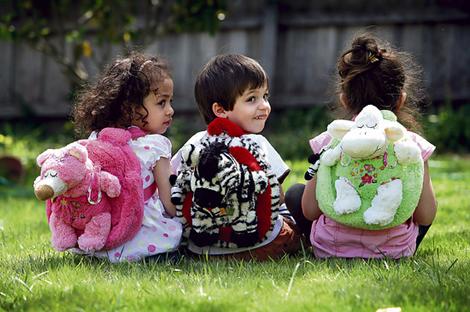Backpacks come in all sizes, colors, fabrics, and shapes and help kids of all ages express their own personal sense of style. And when used properly, they're incredibly handy. Compared with shoulder bags, messenger bags, or purses, backpacks are better because the strongest muscles in the body — the back and the abdominal muscles — support the weight of the packs.
As practical as backpacks are, though, they can strain muscles and joints and may cause back pain if they're too heavy or are used incorrectly.
Problems Backpacks Can Pose
Most doctors and physical therapists recommend that kids carry no more than 10% to 15% of their body weight in their packs.
When a heavy weight, such as a backpack filled with books, is incorrectly placed on the shoulders, the weight's force can pull a child backward. To compensate, a child may bend forward at the hips or arch the back, which can cause the spine to compress unnaturally. The heavy weight might cause some kids to develop shoulder, neck, and back pain.
Kids who wear their backpacks over just one shoulder — as many do, because they think it looks better or just feels easier — may end up leaning to one side to offset the extra weight. They might develop lower and upper back pain and strain their shoulders and neck.
Girls and younger kids may be especially at risk for backpack-related injuries because they're smaller and may carry loads that are heavier in proportion to their body weight.
Also, backpacks with tight, narrow straps that dig into the shoulders can interfere with circulation and nerves. These types of straps can contribute to tingling, numbness, and weakness in the arms and hands.
Purchasing a Safe Pack
Despite their potential problems, backpacks are an excellent tool for kids when used properly. The American Academy of Pediatrics (AAP) recommends that parents look for the following when choosing the right backpack:
- a lightweight pack that doesn't add a lot of weight to your child's load (for example, leather packs weigh more than traditional canvas backpacks)
- two wide, padded shoulder straps; straps that are too narrow can dig into shoulders
- a padded back, which not only provides increased comfort, but also protects kids from being poked by sharp edges on objects (pencils, rulers, notebooks, etc.) inside the pack
- a waist belt, which helps to distribute the weight more evenly across the body
- multiple compartments, which can help distribute the weight more evenly
What Kids Can Do
A lot of the responsibility for packing lightly — and safely — rests with kids:
- Encourage kids to use their locker or desk frequently throughout the day instead of carrying the entire day's worth of books in the backpack.
- Make sure kids don't tote unnecessary items — laptops, cell phones, and video games can add extra pounds to a pack.
- Encourage kids to bring home only the books needed for homework or studying each night.
- Picking up the backpack the right way can also help kids avoid back injuries. As with any heavy weight, they should bend at the knees and grab the pack with both hands when lifting a backpack to the shoulders.
- Use all of the backpack's compartments, putting heavier items, such as textbooks, closest to the center of the back.
If your child has back pain or numbness or weakness in the arms or legs, talk to your doctor or physical therapist.
Source: Kidshealth.org

Your Baby checkup
what are the vaccinations that he should have taken until now?
Generate a report for my baby.
Track Your Baby Vaccinations
Find Your Baby name
Mohandessin
01002195777
01000012400
0233048350
Beverly Hills
01000012900
0238576831
El Tagamo3
Al Sheikh Zayed
02- 38514031
01000608597


